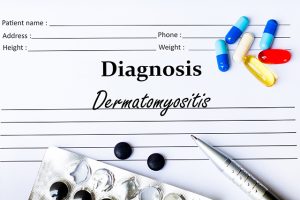
Dermatomyositis – causes, side effects and treatments at NaturalPedia.com
Friday, March 09, 2018 by Ralph Flores
http://www.naturalpedia.com/dermatomyositis-causes-side-effects-and-treatments-at-naturalpedia-com.html

Dermatomyositis (DM) is a rare acquired muscle disease that is characterized by the development of a skin rash prior to progressive muscle weakness. The condition is part of the group of acquired muscle diseases called inflammatory myopathies, that is, a muscle disorder identified by chronic inflammation and progressive muscle weakness.
Aside from dermatomyositis, other inflammatory myopathies include:
- Polymyositis (PM) — muscle inflammation without the rash.
- Juvenile DM/PM — both cases of DM or PM that occur in children below 18 years.
- Amyopathic DM (also called dermatomyositis sine myositis) — a skin rash that does not involve muscle inflammation.
- Antisynthetase syndrome — a combination of myositis, arthritis, interstitial lung disease, mechanic’s hands (a condition where there are cracks and fissures on the radial side of the digits and palms), and Raynaud phenomenon (the discoloration of fingers after being exposed to changes in temperature).
DM is not predisposed to any race, age, or sex. However, its incidence is higher in women than in men. Moreover, it is more common in adults in their late 40s to their early 60s and children between five to 15 years of age.

Known risk factors and symptoms of dermatomyositis
The etiology of DM is unknown; however, some believe that this is either an autoimmune reaction – where the body attacks its own tissues – or a viral infection of the skeletal muscle. In addition, experts believe that certain people may be susceptible to the disease, by virtue of genetics.
Patients with DM will, at first, report the presence of a rash, which can be characterized as either itchy or burning. In most cases, this precedes muscle weakness. Other symptoms include:
- The appearance of reddish or bluish-purple patches in areas that are usually exposed to the sun.
- A violet-colored rash which can appear on the cheeks, nose, shoulders, upper chest, and elbows.
- Heliotrope eyelids or purple-colored eyelids.
- Purple plaques on bony parts of the body, in particular, the knuckles.
- Ragged cuticles or the presence of prominent blood vessels in nail folds.
- A scaly scalp and thinned out hair.
- Poikiloderma, a condition wherein the skin is pale and thin.
The onset of muscle weakness after the appearance of the skin disease may vary from a few weeks to even years after the symptoms were noted. In general, weakness in the muscle will become apparent during walking, or when climbing stairs. In some cases, reaching for items above the shoulders and rising from a seated position will also become fatigued.
Common complications of DM may include the following:
- Skin ulcerations
- Gastric ulcers
- Difficulty breathing
- Infections of the lung
- Problems with swallowing
- Malnutrition
- Weight loss
Body systems affected by dermatomyositis
DM affects the muscles; however, inflammatory cells may surround blood cells in the area and inevitably cause muscle fiber necrosis.
Food items or nutrients that may prevent or relieve dermatomyositis
Proper diet can help people with DM gain energy to move. A study recommended a diet of people with DM, and myositis in general, to have a ratio of 30 percent fat, 50 to 60 percent carbohydrates, and 20 percent protein – following the recommendation for healthy Nordic European individuals. The diet may also be supplemented with the following to increase muscle mass and endurance.
- Fatty acids — Omega-3, found in fatty fish and flaxseed oil, is known to inhibit inflammation.
- Vitamin D — A vitamin that regulates the immune system, it can be found in fortified dairy products, fatty fish, and fish liver oils.
- Vitamin E — A soluble lipid that is known as a potent antioxidant, it can be found in fruits and vegetables.
Moreover, avoiding food items that contain gluten, which may trigger idiopathic inflammatory myopathies, is recommended.
Treatment and management options for dermatomyositis
There is no cure for DM, but its symptoms can be addressed. The standard treatment for the condition are corticosteroids – a type of medication that targets inflammation, pain, and discomfort. Immunosuppressant drugs are also provided when these become ineffective, as well as intravenous immunoglobulin.
Physical therapy is administered to prevent muscle atrophy and get back muscle strength. For skin conditions resulting from DM, topical corticosteroids are given to treat it.
Most cases of DM respond to therapy, with some patients reporting their symptoms to disappear altogether. However, these cases are more common in children. Adults, however, are more prone to the complications of DM, with the outcome becoming worse when the lungs or the heart is affected.
Where to learn more
- Is Dermatomyositis Just Another Word for Gluten Intolerance?
- Health.news
- Medicine.news
- NaturalCures.news
- Herbs.news
Summary
Dermatomyositis is a rare acquired muscle disease that is characterized by the development of a skin rash before progressive muscle weakness. The condition is not predisposed to any race, age, or sex. However, its incidence is higher in women than in men. Moreover, it is more common in adults in their late 40s to their early 60s and children between five to 15 years of age.
The etiology of DM is unknown, but, some believe that this is either an autoimmune reaction or a viral infection of the skeletal muscle. Also, experts think that certain people may be susceptible to the disease, by genetics.
DM affects the muscles; however, inflammatory cells may surround blood cells in the area and inevitably cause muscle fiber necrosis.
There is currently no cure for DM, but its symptoms can be addressed.
Sources include:
Tagged Under: Tags: dermatomyositis





